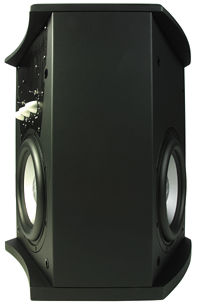MartinLogan Descent subwoofer Page 2
 Finally, the drivers are servo-controlled—their performance is monitored continuously, and self-corrected when distortion rises. Up to 800W (400W continuous) are on tap, so maintaining such low distortion at high levels, if ML can actually pull it off, is truly an engineering miracle.
Finally, the drivers are servo-controlled—their performance is monitored continuously, and self-corrected when distortion rises. Up to 800W (400W continuous) are on tap, so maintaining such low distortion at high levels, if ML can actually pull it off, is truly an engineering miracle.
Hear Ye, Hear Ye
The Descent is the most beautiful-looking subwoofer I've seen since the discontinued Muse 18, but sound is what we're after. MartinLogan claims a -3dB point of 20Hz, and from my experiences in my room, I wouldn't be surprised if that were a very conservative figure. Cranking up "Welcome to the Machine," from Pink Floyd's Wish You Were Here gold CD (Columbia MasterSound CK 64405), I used the Descent's 25Hz level control to take advantage of the track's sub-harmonics. Alternately adding and cutting at 25Hz, I could clearly discern the amount of information present in that region—back at my listening couch, I thought I'd invested in one of those Sharper Image massage chairs. A bit annoying for anyone else in the house, but oh, so relaxing. Pushing the limits (mine, not the Descent's), I was able to dig up 110dB bass peaks—not a meter away from the speaker, but at my seat. The shocking truth? The Descent is a sexy beast.
Many people make the forgivable mistake of cranking their baby subs up enough to make their home theaters exciting. The havoc this wreaks on their music is predictable—there's such a thing as too much bass, particularly with music. Well, now that I've forgiven everyone, I have to add that, with a subwoofer as clean-sounding as the Descent, I, too, wasn't beyond cranking it up—and leaving it there. It didn't take too long to admit that electric-bass players really do turn it up that loud when playing live. What the Descent added to the foundation of my already full-range Prodigy speakers was significant. What it added to my choice for speaker of the year, the Thiel CS1.6, was indispensable!
Proper subwoofer setup means experimentation and listening. When in doubt, turn the Descent down and concentrate on tonality. The drivers did loosen considerably as they broke in over two full months. To bide my time, I listened to oodles of music, jamming along on guitar for hours on end. The Descent brought to life the bass player I never had. Whether scooping out all the low frequencies for the Thiel CS1.6 system, or merely supplementing what was already available with my MartinLogan array of Prodigy, ReQuest, and Theater speakers, the Descent subwoofer proved adroit at system integration.
Playing around with my ML setup of Prodigys plus Descent, I moved the sub away from the brick hearth (near-wall) location farther into the room, and adjusted for the slight drop in level with a clockwise nudge of the sub's level control. The Descent then became a bit more articulate and distinct, if slightly more directional. Listening to Mark Knopfler's bass-heavy Sailing to Philadelphia CD (Warner Bros. 47753-2), the bass was spine-tinglingly deep, but the slightest bit of room-induced overhang necessitated a return to the near-wall position, where the overall response was much smoother and just as articulate.
On the We Were Soldiers DVD (Paramount 34002), the first major battle scene (chapter 8) has plenty of automatic-rifle fire—with its center grillecloth off, the Descent looked as if it was firing off volleys as well. The large amount of mid- to high-frequency energy may have been what was most apparent, but one look at the Descent's metallic-colored piston taking aim at the enemy and I had no doubt where all the fear and anxiety were coming from. The Descent looked capable—was capable—of a good amount of excursion: 1.2 inches peak-to-peak, according to MartinLogan.
Nothing I threw at the Descent threw it for a loop. The small woofers in the ML Theater center-channel speaker bottomed out well before I could reach a level where the Descent showed even the slightest sign of stress. Switching to 2-channel plus sub only, I chickened out before the subwoofer did.
The MartinLogan Descent is a powerful subwoofer, but is it musical? The short answer: a definite yes. More important, it seemed very easy to get good results with music. When I rested my hand on the top of the cabinet to test ML's rebuttal to Newton's Third Law, I felt only minimal vibration.
Buy Ye, Buy Ye
In the last five years, ML has learned plenty about bass; I expect the Descent is just the first in a line of wonderful subs to use "out of the box" thinking. The Descent is one of the finest subwoofers I've had the privilege of knowing, and worth every cold hard penny it will cost to make her your bride.




























































